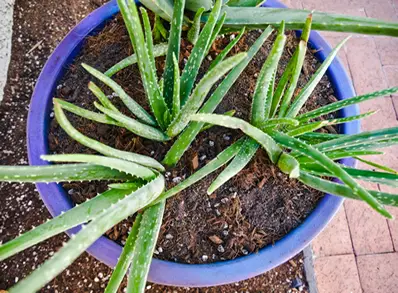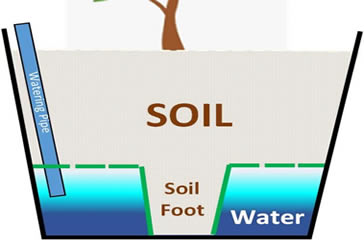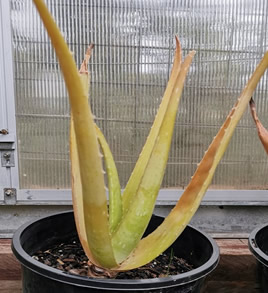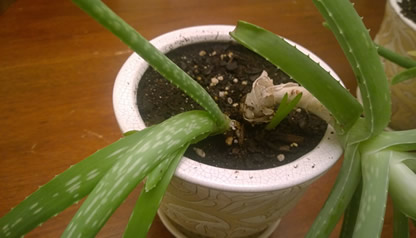In this article I will tell you everything you need to know about watering aloe plants. I will also outline the potential problems that can arise from underwatering and overwatering your aloe plant and the steps you need to take to save your plant should you encounter these problems.
Table of Contents
Aloe plant watering care
The aloe plant is a tropical succulent that grows in very dry areas. Native to parts of Africa, Madagascar, Jordan, the Arabian Peninsula and various islands in the Indian Ocean such as Mauritius, Réunion and Comoros, the aloe is a hardy desert plant that thrives is some very challenging conditions.
Aloe plants have evolved to thrive in areas where water is scarce, the temperatures are high and sunlight is strong (see our guide to aloe plant sun and light needs). This is one reason why aloe plants grow so well when planted in rock and they will even grow in sandy soil.
Because the aloe has become so well adapted to scarce water conditions this plant must be watered very sparingly. Getting an aloe plant’s water care correct is essential.
Although I have seen cases of underwatered aloe plants I have seen many, many more plants that are suffering from overwatering. It is much more difficult to underwater a desert plant than it is to overwater one. However, I will cover both scenarios and their fixes later in this article.
There are 500 different species of aloe plant with the most popular aloe houseplant being aloe vera. Luckily though, all aloe plants require the same water care so regardless of which specific aloe species you have, the information contained in this article will benefit you.
How to know if your aloe plant needs water
So what are the signs that your aloe plant needs to be watered?
You will know that your aloe plant needs watered when the soil dries out. The top 1 ½ – 2 inches of soil should be dry before applying more water to the plant. Drooping leaves, yellow leaves or leaves with brown tips (when accompanied by very dry soil), can be an indication that your aloe plant needs watered.
Be careful not to automatically assume that drooping leaves on a aloe plant means the plant needs to be watered. Drooping leaves can also be caused by the dehydration that stems from overwatering – as counterintuitive as dehydration due to overwatering may sound. I cover this subject in more depth below.

If your aloe plant has drooping leaves and the soil is very dry then it is very likely you need to water the plant. Before you do this though always check for root rot (which I show you how to do later) as drooping leaves are also a sign of overwatering.
To determine if the soil is dry you can use my finger-test. If you are a regular visitor to this website then you will be well practiced in this technique. For those of you who do not know what it is I will briefly cover the simple steps it involves now.
2 Ways to test aloe soil for sufficient moisture
The first way to test if there is sufficient moisture in your plant’s soil, in this case we will test the soil of an aloe plant, you will use your finger.
Normally, with the type of houseplants that require the soil to dry out before watering, you would allow only the top 1 inch of soil to dry before giving the plant water.
With aloe plants though I prefer to wait until at least 1 ½ inches of soil have dried out, and in winter I will allow up to 2 inches of the soil to dry, before watering.
So how do you know how much moisture is in the soil and when enough of the top layer has dried out? Well, you use the finger test of course. 🙂
By pushing your finger into the soil you can determine if there is moisture there or if the soil is completely dry.
Normally you would push your finger down into the soil to the first bend, this is roughly 1″.
With aloe plants I suggest you push you finger further down, so it is in the soil to the point where you are halfway past the first bend of your finger moving towards the second bend. See the image below.

When you remove your finger from the soil it will either be dry or have some soil residue on it.
If there is soil residue sticking to your finger then the soil still has moisture. If your finger comes up dry then the soil is dry enough that you need to water your aloe plant.
The finger test is not an exact science and you will rarely remove your finger and have it be completely soil free but you only need to do this once or twice to learn the difference between wet soil and dry soil.
If you are ever in doubt simply water the aloe plant after 3 weeks. Do not let it go longer than 3 weeks without watering it but don’t water it more than every 2 weeks.
The second way to test if there is sufficient moisture in your aloe plant’s soil is to use moisture meter. Obviously this is a more scientific approach and although these meters are very cheap (see these) the finger test will usually suffice.
The amount of water you should give an aloe plant during watering
Aloe plants evolved in very dry conditions. As a desert plant an aloe does not need a lot of water. SO, how much water should you give an aloe plant?
Aloe plants require very little water compared to other houseplants. As a general rule water your aloe plant every 3 weeks. Water from the bottom and leave the plant sitting in the water for no longer than 20 minutes.
Aloe plants are hardy and very resistant to drought conditions.
Obviously you do not want to leave your plant without water for very long periods of time but an aloe plant will bounce back much easier from underetering than it will from overwatering. So, always be conservative when watering an aloe plant. With aloe plants less is more when it comes to watering.
I wouldn’t allow your plant to go any more than 3 weeks without watering it though you should not water it any more than every 2 weeks. Personally, I advise you to perform the finger test I mentioned above before watering an aloe plant at least until such time when you understand the specific watering needs of your individual plant.
How to water an aloe plant correctly
With some houseplants preferring to be watered from the top and others preferring to be watered from the bottom how do you water an aloe plant?
Aloe plants should be watered from the bottom. Whenever possible you should avoid watering aloe plants from the top to avoid getting the leaves wet. Sit your aloe plant in water for about 20 minutes every 3 weeks or when the soil dries out to a depth of 1 ½”. Alternatively use a self-watering pot.
Aloe plant leaves do not like to get wet. For this reason I always water aloe plants from the bottom.
Because aloe plants are best watered from the bottom they are perfect candidates for self-watering pots. Not only do self-watering pots take away the need for watering the plant but they also help to maintain good humidity levels in the plant’s localized environment.

Although it is possible to water the plant from the top I do not recommend it. No matter how careful you are, if you continually water your aloe plant from the top, sooner or later you will wet the leaves. Wetting the leaves can lead to leaf rot.
The proper frequency for watering an aloe plant – how often to water
As aloe plants are mostly grown as houseplants you will likely want to know how often you should water them.
As a general rule-of-thumb you should water an aloe plant every 3 weeks. However, a more accurate way of telling when you need to water your plant is to test the soil for moistness. When the top 1 ½ – 2 inches of soil dries out the plant needs watered. Use the finger test to determine soil moisture levels.
Although it is fairly safe to water your aloe plant every 3 weeks I suggest you do the finger test several times (over 2 – 3 months) so you can learn the specific watering needs of your aloe plant. You see different homes have different climatic conditions with some homes being warmer or cooler than others and some having higher humidity levels than others. This means that an aloe plant in one home may need more water than the same plant would need in another home.
So although a 3-week watering routine is fine, if you test the soil of your plant for moisture you may find that your plant needs watered more often or less often that this. If checking soil moisture levels is not an option then simply stick to a 3 week watering schedule and look for signs of overwatering or underwatering after several weeks. In most cases your plant will be fine with this schedule as most US homes have very similar conditions.
2 Major aloe plant watering concerns
Below I highlight a few potential problems that can arise from an incorrect aloe plant watering routine.
Obviously the two main concerns when it comes to aloe watering is underwatering and overwatering. So, let’s look at each of these potential problems in turn and what you need to do to deal with them.
1. The effects of underwatering an aloe plant
An underwatered aloe plant will show signs of dehydration. I will outline these telltale signs below but you must be careful when diagnosing potential problems with watering when it comes to aloe plants because the same signs that indicate underwatering are often the very same signs that can indicate overwatering. I know this sounds counterintuitive so I will quickly explain why this is the case.
When an aloe plant is not given enough water the foliage will show signs of dehydration. This is obviously to be expected when the plant is not getting enough water. However, when an aloe plant is overwatered is will also become dehydrated as strange as that may sound. Why is this?
Overwatering a plant, especially a succulent like aloe, will lead to root rot. When the roots of the plant begin to rot they become incapable of absorbing the moisture from the soil and distributing it to the foliage. Hence, the plant becomes dehydrated even though it is almost “swimming” in water.
So, before immediately coming to the conclusion your aloe plant needs watered you should first check the soil for moisture and if the soil seems to have more than enough moisture in it you will need to look for signs of root rot.
As a side note: both underwatered and overwatered aloe will refuse to bloom (see our aloe blooms guide).
What an underwatered aloe plant looks like
An underwatered aloe plant will look dehydrated. The leaves of the plant will also fade in color and may take on a yellow type hue and/or they can develop brown tips.
Although a yellowing of the leaves can also indicate sun bleaching, aloe plants are very resistant to strong sun and actually grow best in direct sunlight. So, when you see yellowing leaves on an aloe plant you should first check the soil for moisture as the most likely cause is dehydration due to insufficient watering.

Additionally, if the dehydration in aloe leaves has been caused by a lack of water, rather than overwatering, then the soil will be completely dry and there will be zero signs of root rot.
2. The disastrous effects of overwatering an aloe plant
Overwatering an aloe plant is a much more serious problem than underwatering. An underwatered aloe will quickly recover once a consistent and healthy watering routine is restored. However when an aloe is overwatered drastic and immediate action must be taken to save the plant.
As you can see in the image below the leaves of the aloe plant are drooping and the soil is visibly moist. These are strong indications that the aloe plant has been overwatered. Further investigation will determine if root rot has taken hold and the plant needs repotted or if the soil simply needs to be allowed to dry out (repotting in drier soil is also advisable though not completely necessary if there is no root rot).
What an overwatered aloe plant looks like
An overwatered aloe plant may sometimes have the same surface-level appearance as an underwatered aloe because both plants are dehydrated. So just because the plant has yellow leaves that are upright this does not automatically mean the plant needs to be watered.
However, when it comes to an overwatered aloe plant there will be clear signs of much more serious distress in the plant. The leaves may remain their normal green color (but not always) and they may droop causing the plant to fall over.

Be aware, as I have already stated, that the signs which indicate underwatering can also be the same signs that point to overwatering. So if your aloe plant leaves are turning yellow and are not drooping this can also mean the plant has been overwatered and is suffering from root rot.
Always check for signs of overwatering before watering the plant!
How to identify root rot in aloe plants
To tell if your aloe plant, or aloe vera, is suffering from root rot look first at the stems of the leaves. Dark brown, black or mushy stems are all indications of root rot.
If these signs are evident then you will need to remove the plant from its pot.
Root rot is easy to spot as the roots of the plant will be blackened. If the root rot is particularly bad you may find that the roots themselves completely separate from the plant as you remove it from the soil.
To treat root rot in any aloe plant follow my instructions for treating aloe vera root rot as the process is exactly the same for treating root rot in all aloe plants.
For more information on the general care of aloe read our ultimate aloe plant care guide.

